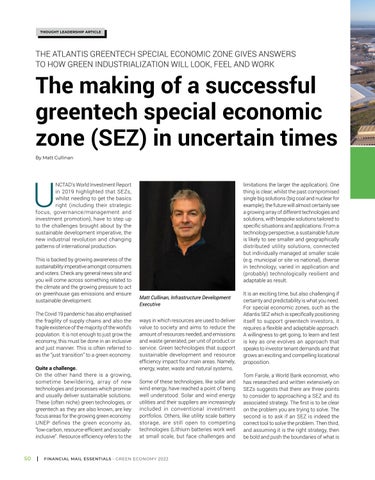THOUGHT LEADERSHIP ARTICLE
The Atlantis Greentech Special Economic Zone gives answers to how green industrialization will look, feel and work
The making of a successful greentech special economic zone (SEZ) in uncertain times By Matt Cullinan
U
NCTAD’s World Investment Report in 2019 highlighted that SEZs, whilst needing to get the basics right (including their strategic focus, governance/management and investment promotion), have to step up to the challenges brought about by the sustainable development imperative, the new industrial revolution and changing patterns of international production. This is backed by growing awareness of the sustainability imperative amongst consumers and voters. Check any general news site and you will come across something related to the climate and the growing pressure to act on greenhouse gas emissions and ensure sustainable development. The Covid 19 pandemic has also emphasised the fragility of supply chains and also the fragile existence of the majority of the world’s population. It is not enough to just grow the economy, this must be done in an inclusive and just manner. This is often referred to as the “just transition” to a green economy. Quite a challenge. On the other hand there is a growing, sometime bewildering, array of new technologies and processes which promise and usually deliver sustainable solutions. These (often niche) green technologies, or greentech as they are also known, are key focus areas for the growing green economy. UNEP defines the green economy as, “low-carbon, resource-efficient and sociallyinclusive”. Resource efficiency refers to the
50
|
limitations the larger the application). One thing is clear, whilst the past compromised single big solutions (big coal and nuclear for example), the future will almost certainly see a growing array of different technologies and solutions, with bespoke solutions tailored to specific situations and applications. From a technology perspective, a sustainable future is likely to see smaller and geographically distributed utility solutions, connected but individually managed at smaller scale (e.g. municipal or site vs national), diverse in technology, varied in application and (probably) technologically resilient and adaptable as result. Matt Cullinan, Infrastructure Development Executive ways in which resources are used to deliver value to society and aims to reduce the amount of resources needed, and emissions and waste generated, per unit of product or service. Green technologies that support sustainable development and resource efficiency impact four main areas. Namely, energy, water, waste and natural systems. Some of these technologies, like solar and wind energy, have reached a point of being well understood. Solar and wind energy utilities and their suppliers are increasingly included in conventional investment portfolios. Others, like utility scale battery storage, are still open to competing technologies (Lithium batteries work well at small scale, but face challenges and
FINANCIAL MAIL ESSENTIALS • GREEN ECONOMY 2022
It is an exciting time, but also challenging if certainty and predictability is what you need. For special economic zones, such as the Atlantis SEZ which is specifically positioning itself to support greentech investors, it requires a flexible and adaptable approach. A willingness to get going, to learn and test is key as one evolves an approach that speaks to investor tenant demands and that grows an exciting and compelling locational proposition. Tom Farole, a World Bank economist, who has researched and written extensively on SEZs suggests that there are three points to consider to approaching a SEZ and its associated strategy. The first is to be clear on the problem you are trying to solve. The second is to ask if an SEZ is indeed the correct tool to solve the problem. Then third, and assuming it is the right strategy, then be bold and push the boundaries of what is
















